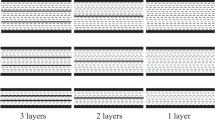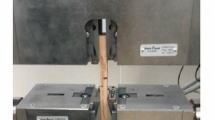The application of an artificial neural networks (ANN) to predicting the bending strength of a laminated veneer lumber (LVL) manufactured under different conditions is considered. First, experimental studies were conducted, and then an ANN model was developed based on the experimental data obtained. LVL specimens of walnut wood, glued with urea-formaldehyde resins containing a chemically modified starch and nanocellulose, were obtained by pressing for different times. Experimental results for them showed that the direct effect of the press time, the square effect of the modified starch, and the joint effect of them had the highest statistical significance to the bending strength of LVL. The ANN model developed gave good predictions for the bending strength, well agreeing with experimental data.





Similar content being viewed by others
References
G. Nemli, I. Aydın, and E. Zekovic, “Evaluation of some of the properties of particleboard as function of manufacturing parameters,” Mater. Des., 28, No. 4, 1169-1176 (2007).
J. Petinarakis and P. Kavvouras, “Technological factors affecting the emission of formaldehyde from particleboards,” Wood Res-Slovakia., 51, No. 1, 31- 40 (2006).
M. Salem, M. Bohm, S. Barcik, and J. Berankova, “Formaldehyde emission from wood-based panels bonded with different formaldehyde-based resins,” Drvna Ind., 62, No. 3, 177-183 (2011).
E. Minopoulou, E. Dessipri, G. D. Chryssikos, V. Gionis, A. Paipetis, and C. Panayiotou, “Use of NIR for structural characterization of urea–formaldehyde resins,” Int. J. Adhes. Adhes., 23, No. 6, 473-484 (2003).
M. Liu, R. V. K. G. Thirumalai, Y. Wu, and H. Wan, “Characterization of the crystalline regions of cured urea formaldehyde resin,” RSC Adv., 7, No. 78, 49536-49541 (2017).
W. Lum, S. H. Lee, and P. H’ng, “Effects of formaldehyde catcher on some properties of particleboard with different ratio of surface to core layer,” Asian J. Appl. Sci., 7, No. 1, 22-29 (2014).
B. D. Park and J. W. Kim, “Dynamic mechanical analysis of urea–formaldehyde resin adhesives with different formaldehyde-to-urea molar ratios,” J. Appl. Polym. Sci., 108, No. 3, 2045-2051, (2008).
Y. Liu, J. Shen, and X. D. Zhu, “Evaluation of mechanical properties and formaldehyde emissions of particleboards with nanomaterial-added melamine-impregnated papers,” Eur. J. Wood Wood Prod., 73, No. 4, 449-55 (2015).
N. Nikvash, A. Kharazipour, and M. Euring, “Effects of wheat protein as a bio binder in the manufacture of particleboards using a mixture of canola, hemp, bagasse and commercial wood,” Forest Prod. J., 62, No. 1, 49-57 (2012)
B. Biduski, F. T. d. Silva, W. M. d. Silva, S. L. d. M. E. Halal, V. Z. Pinto, and A. R. G. Dias, “Impact of acid and oxidative modifications, single or dual, of sorghum starch on biodegradable films,” Food Chem., 214, 53-60 (2017).
J. Liu, B. Wang, L. Lin, J. Zhang, W. Liu, and J. Xie, “Functional, physicochemical properties and structure of crosslinked oxidized maize starch,” Food Hydrocoll., 36, 45-52 (2014).
B. Wei, H. Li, Y. Tian, X. Xu, and Z. Jin, “Thermal degradation behavior of hypochlorite-oxidized starch nanocrystals under different oxidized levels,” Carbohydr. Polym., 124, 124-130 (2015).
Y. R. Zhang, X. L. Wang, G. M. Zhao, and Y. Z. Wang, “Preparation and properties of oxidized starch with high degree of oxidation,” Carbohydr. Polym., 87, No. 4, 2554-2562 (2012).
E. M. Ciannamea, J. F. Martucci, P. M. Stefani, and R. A. Ruseckaite, “Bonding quality of chemically-modified soybean protein concentrate-based adhesives in particleboards from rice husks,” J. Am. Oil. Chem. Soc., 89, No. 9, 1733-1741 (2012).
R. Widyorini, K. Umemura, A. R. Kusumaningtyas, and T. A. Prayitno, “Effect of starch addition on properties of citric acid-bonded particleboard made from bamboo,” BioResources, 12, No. 4, 8068–8077 (2017).
P. Zheng, Q. Lin, F. Li, Y. Ou, and N. Chen , “Development and characterization of a defatted soy flour-based bioadhesive crosslinked by 1,2,3,4-butanetetracarboxylic acid,” Int. J. Adhes. Adhes., 78, 148-154 (2017).
R. Gadhave, P. Mahanwar, and P. Gadekar, “Factor affecting gel time/process-ability of urea formaldehyde resin based wood adhesives,” Open J. Polym. Chem., 7, 33-42 (2017).
P. S. Garcia, M. V. E. Grossmann, M. A. Shirai, M. M. Lazaretti, F. Yamashita, C. M. O. Muller, and S. Mali, “Improving action of citric acid as compatibiliser in starch/polyester blown films,” Ind. Crops Prod., 52, 305-312 (2014).
E. Olsson, M. S. Hedenqvist, C. Johansson, and L. Järnström, “Influence of citric acid and curing on moisture sorption, diffusion and permeability of starch films,” Carbohydr. Polym., 94, No. 2, 765-772 (2013).
S. Bardak, S. Tiryaki, G. Nemli, and A. Aydın, “Investigation and neural network prediction of wood bonding quality based on pressing conditions,” Int. J. Adhes. Adhes., 68, 115-123 (2016).
C. Demirkir, Ş. Özsahin, I. Aydin, and G. Colakoglu, “Optimization of some panel manufacturing parameters for the best bonding strength of plywood,” Int. J. Adhes Adhes., 46, 14-20 (2013).
F. G. Fernández, P. de Palacios, L. G. Esteban, A. Garcia-Iruela, B. G. Rodrigo, and E. Menasalvas, “Prediction of MOR and MOE of structural plywood board using an artificial neural network and comparison with a multivariate regression model,” Compos. B Eng., 43, No. 8, 3528-3533 (2012).
İ. Akyüz, Ş. Özşahin, S. Tiryaki, and A. Aydın, “An application of artificial neural networks for modeling formaldehyde emission based on process parameters in particleboard manufacturing process,” Clean Technol. Envir., 19, No. 5, 1449-1458 (2017).
European Committee for Standardization (CEN). Wood-based panels. Determination of modulus of elasticity in bending and of bending strength. Standard EN 310. Brussels: CEN, (1993).
K. Manonmani, N. Murugan, and G. Buvanasekaran, “Effects of process parameters on the bead geometry of laser beam butt welded stainless steel sheets,” Int. J. Adv. Manuf. Tech., 32, No. 11, 1125-1133 (2007).
S. Tiryaki and C. Hamzaçebi, “Predicting modulus of rupture (MOR) and modulus of elasticity (MOE) of heat treated woods by artificial neural networks,” Measurement, 49, 266-274 (2014).
Y. Erzin and T. Cetin, “The prediction of the critical factor of safety of homogeneous finite slopes using neural networks and multiple regressions,” Comput. Geosci., 51, 305-313 (2013).
P. C. Williams, in: P. Williams and K. Norris (eds.), Near-Infrared Technology in the Agricultural and Food Industries, Ch. 8, Second ed., American Association of Cereal Chemists, USA, (2001), pp. 145-69.
S. Tiryaki, S. Ozsahin and I. Yildirim, “Comparison of artificial neural network and multiple linear regression models to predict optimum bonding strength of heat treated woods,” Int. J. Adhes. Adhes., 55, 29-36 (2014).
C. D. Lewis, International and business forecasting methods. Butterworths Publishing, London (1982).
H. Wang, J. Liang, J. Zhang, X. Zhou and G. Du, “Performance of urea-formaldehyde adhesive with oxidized cassava starch,” BioResources, 12, 7590-7600 (2017).
J. Luo, J. Zhang, Q. Gao, A. Mao and J. Li, “Toughening and enhancing melamine–urea–formaldehyde resin properties via in situ polymerization of dialdehyde starch and microphase separation,” Polymers, 11, No. 7, 1167 (2019).
P. Li, Y. Wu, W. Liu, Y. Zuo, J. Lü, and R. Tu, “Preparation of resorcinol-dialdehyde starch-formaldehyde copolycondensation resin adhesive,” Gaofenzi Cailiao Kexue Yu Gongcheng/ Polym. Mater. Sci. Eng., 35, 122-129 (2019).
N. Ayrilmis, J. H. Kwon, S. H. Lee, T. H. Han, and C. W. Park, “ Microfibrillated-cellulose-modified urea-formaldehyde adhesives with different U:F molar ratios for wood-based composites,” J. Adhes. Sci. Technol., 30, No. 18, 2032-2043 (2016).
D. J. Gardner, G. S. Oporto, R. Mills and M. A. S. A. Samir, “Adhesion and surface issues in cellulose and nanocellulose,” J. Adhes. Sci. Technol., 22, No. (5-6), 545-567 (2008).
S. Veigel, U. Müller, J. Keckes, M. Obersriebnig, and W. Gindl-Altmutter, “Cellulose nanofibrils as filler for adhesives: Effect on specific fracture energy of solid wood-adhesive bonds,” Cellulose., 18, No. 1, 1227-1237 (2011).
E. Mahrdt, S. Pinkl, C. Schmidberger, H. W. G. van Herwijnen, S. Veigel, and W. Gindl-Altmutter, “Effect of addition of microfibrillated cellulose to urea-formaldehyde on selected adhesive characteristics and distribution in particle board,” Cellulose, 23, No. 1, 571-580 (2016).
C. Loxton, A. Thumm, W. Grigsby, T. A. Adams, and R. M. Ede, “Resin distribution in medium density fiberboard. Quantification of UF resin distribution on blowline- and dry-blended MDF fiber and panels,” Wood fiber Sci., 35, No. 3, 370-380 (2003).
H. Zhang, J. Zhang, S. Song, G. Wu, and J. Pu, “Modified nanocrystalline cellulose from two kinds of modifiers used for improving formaldehyde emission and bonding strength of ureaformaldehyde resin adhesive,” Bioresources, 6, No. 4, 4430-4438 (2011).
X.-f. Zhao, L.-q. Peng, H.-l. Wang, Y.-b. Wang, and H. Zhang, “Environment-friendly urea-oxidized starch adhesive with zero formaldehyde-emission,” Carbohydr. Polym., 181, 1112-1118 (2018).
X. Jiang, C. Li, Y. Chi, and J. Yan, “TG-FTIR study on urea-formaldehyde resin residue during pyrolysis and combustion,” J. Hazard. Mater., 173, No. 1, 205-210 (2010).
N. S. Sulaiman, R. Hashim, O. Sulaiman, M. Nasir, M. H. M. Amini, and S. Hiziroglu, “Partial replacement of ureaformaldehyde with modified oil palm starch based adhesive to fabricate particleboard,” Int. J. Adhes Adhes., 84, 1-8 (2018).
G. Hamdi and G. Ponchel, “Enzymatic degradation of epichlorohydrin crosslinked starch microspheres by α-amylase,” Pharm. Res., 16, No. 6, 867-875 (1999).
M. Dunky, in: A. Pizzi, L. M. Kashmiri (eds.), Handbook of Adhesive Technology, Ch. 47, Second ed., Taylor & Francis Group, LLC (2003).
Acknowledgment
Authors gratefully acknowledge the Bio-systems Laboratory of Shahid Beheshti University for the technical support.
Author information
Authors and Affiliations
Corresponding author
Additional information
Russian translation published in Mekhanika Kompozitnykh Materialov, Vol. 56, No. 5, pp. 945-966, September-October, 2020.
Rights and permissions
About this article
Cite this article
Nazerian, M., Razavi, S.A., Partovinia, A. et al. Prediction of the Bending Strength of a Laminated Veneer Lumber (LVL) Using an Artificial Neural Network. Mech Compos Mater 56, 649–664 (2020). https://doi.org/10.1007/s11029-020-09911-4
Received:
Revised:
Published:
Issue Date:
DOI: https://doi.org/10.1007/s11029-020-09911-4




